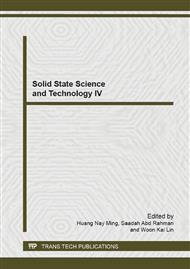p.35
p.41
p.45
p.51
p.57
p.63
p.71
p.75
p.79
Effects of Nitridation Temperatures on Gallium Nitride Thin Films Formed on Silicon Substrates
Abstract:
In this article, GaN thin films were successfully grown on p-type silicon (p-Si) substrates with orientation (100) through spin coating method followed by nitridation in ammonia ambient at various temperatures (750 °C, 850 °C, and 950 °C). The morphology of the GaN thin films were performed by using field-emission scanning electron microscopy. The results showed that the grain size increases with increasing nitridation temperature from 750 °C to 950 °C. Optical analysis of the GaN thin films was performed using Fourier transform infrared spectroscopy. It was confirmed from the results that the reflectance intensity of the transverse optical and longitudinal optical phonon modes of wurtzite GaN increases with increasing nitridation temperature. All the measured results show that nitridation temperature plays a very important role in improving the quality of the GaN thin films. Finally, the results revealed that the 950 °C was the optimal growth nitridation temperature for synthesizing GaN thin film.
Info:
Periodical:
Pages:
57-62
Citation:
Online since:
February 2014
Keywords:
Price:
Сopyright:
© 2014 Trans Tech Publications Ltd. All Rights Reserved
Share:
Citation:


